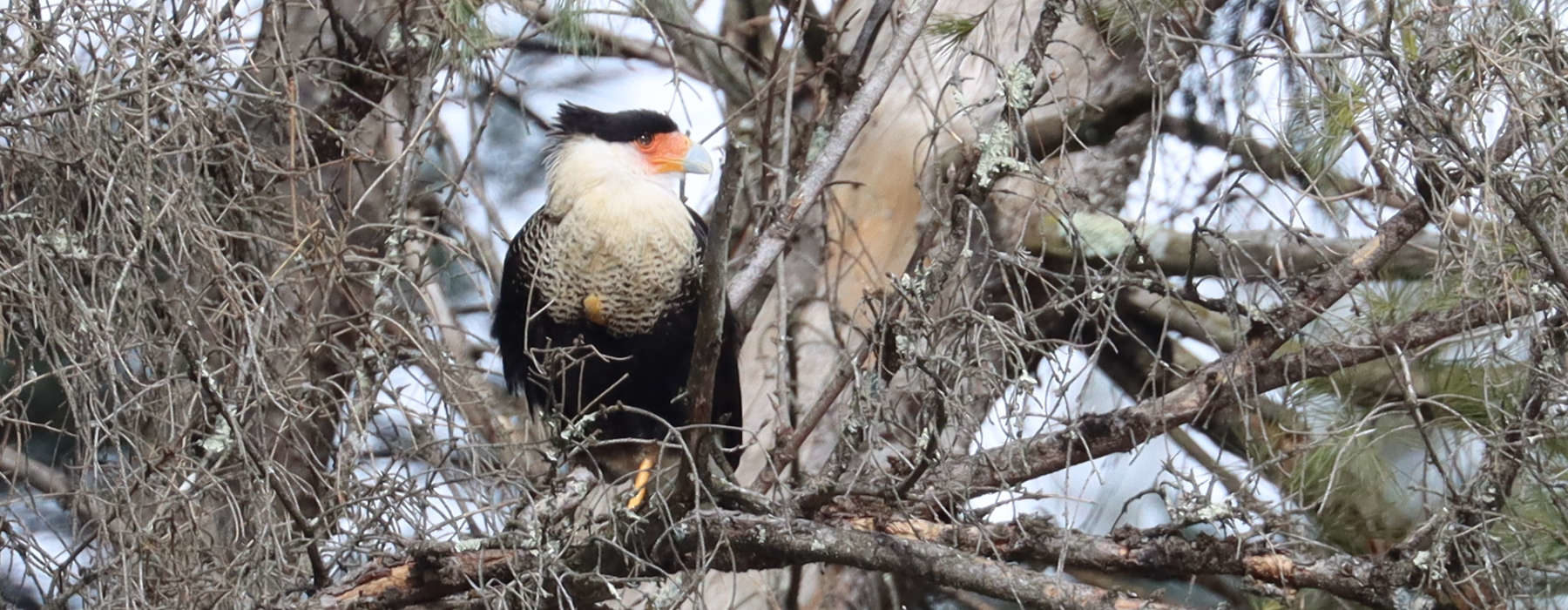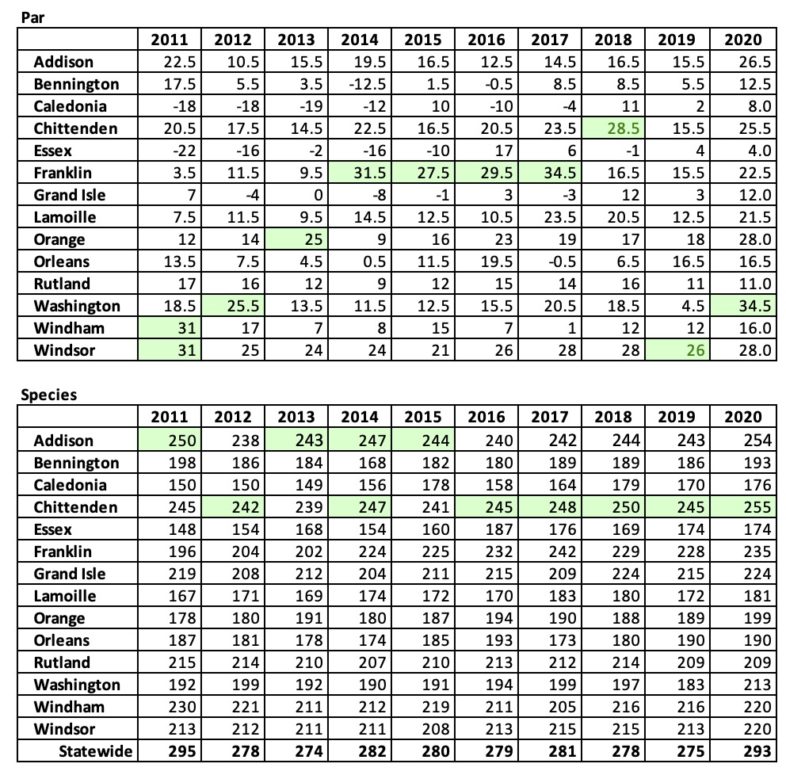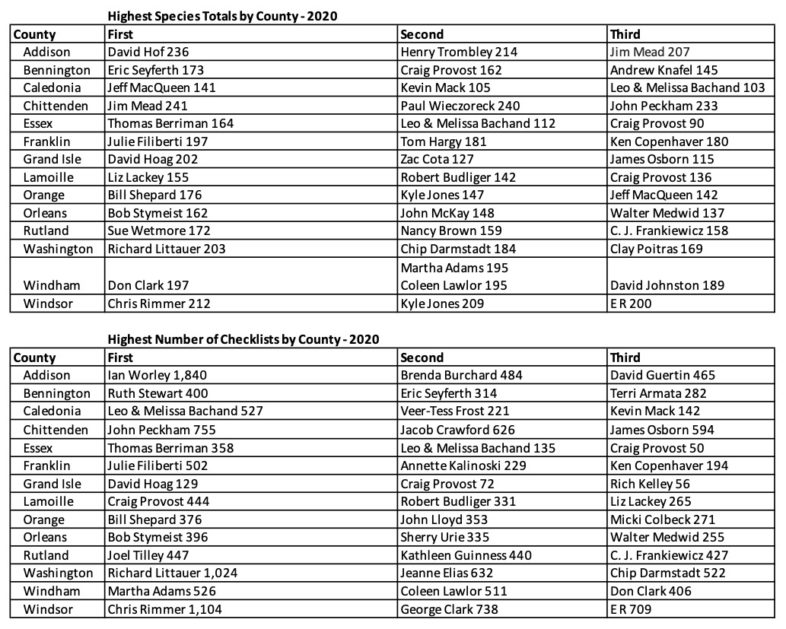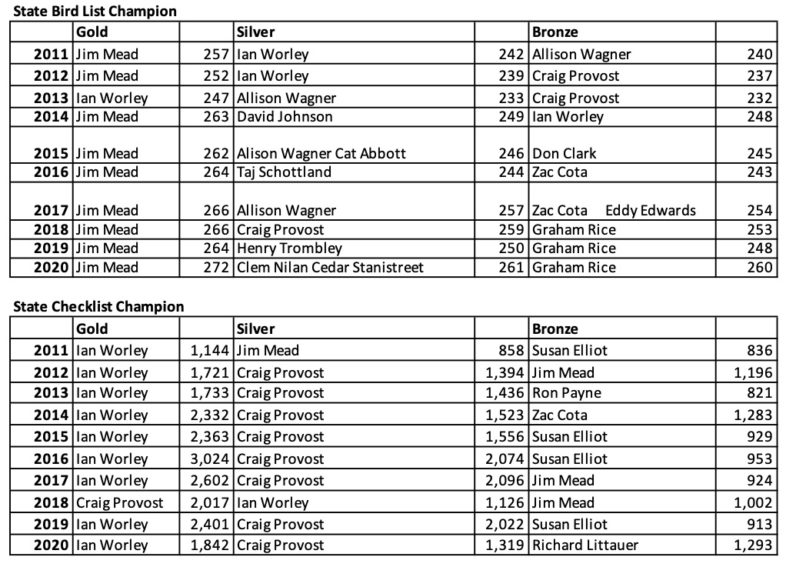From the first day of 2020 when eBirders reported an incredible 81 bird species, to the discovery of a Crested Caracara in Woodstock, Vermont birders scoured fields and fens, mountains and meadows, lakes and lawns to find as many bird species as possible during the 10th annual Vermont eBird County Quest. In the process, they also collected invaluable data for science and conservation.
The annual year-long contest pits county versus county, birder against birder, all engaged in a friendly rivalry for top birding honors. The main idea behind the year-long Quest is simply to get people out birding, promote camaraderie, and better document bird life across the state using Vermont eBird.
2020 marked the 17th year for Vermont eBird, the first state or provincial portal for eBird. Bird watchers have shared an astounding number of checklists, making Vermont eBird (a project of the Vermont Atlas of Life) the largest citizen science biodiversity project in the state. In 2020 2,850 eBirders contributed 100,020 checklists.
Since 2003, more than 10,000 Vermont eBirders have submitted nearly 500,000 complete checklists, representing all 389 species of birds ever reported from Vermont. We’ve added over 108,000 images, nearly 8,000 sound recordings, and 85 videos to Vermont checklists, creating an incredible open access resource for all.
It isn’t just about Vermont. More than 915 million bird sightings have now been entered into eBird worldwide. This includes more than 169 million observations submitted this year; with 26,929,000 sightings from May 2020 alone. This translates into more than 36,100 bird observations every hour in May, 24 hours a day—all month.
Science and Conservation
And, of course, eBird isn’t all just for fun. It’s for science and conservation, too. 2020 was a milestone year for eBird, delivering a new era of scientific and conservation applications, innovative new birding tools, and much more. As always, all of this is 100% free of charge to anyone who wishes to use it.
2020 featured two exciting updates to eBird Status and Trends, which now provides state-of-the-art visualizations of movement, distribution, and abundance for 807 species worldwide, including 82 species modeled outside of the Americas for the first time—all thanks to your eBird checklists. Explore eBird Status and Trends.
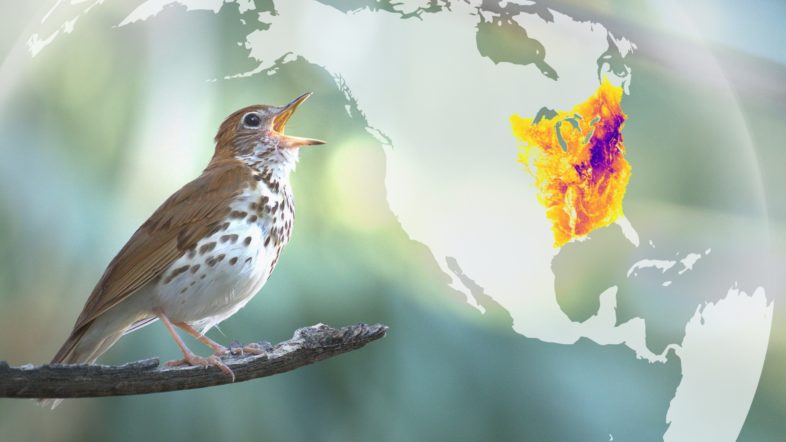
Abundance map for Wood Thrush. Check out the animated map of abundance for the entire annual cycle!

The abundance and range data tables are a great way to learn about what percentage of the population occurs in each state or region throughout the year. Not only can this information help you find more birds, the abundance and range numbers quickly pinpoint the states and regions critical for population survival. Learn more about regional stats and how you can use them.
Researchers published 93 peer-reviewed publications this year incorporating eBird data. eBird powered multiple scientific discoveries including: large urban green spaces support more species; protected areas preserve global biodiversity; and species differ in their resilience to extreme weather events.
Green Mountain eBirders Put Up Huge Numbers in 2020
With over 3,340 Vermont eBirders recording 293 bird species in 2020, there’s no doubt it was a record year for birders and eBird alike. Perhaps this year more than ever, birders sought refuge in nature and watching birds.
The 10th Annual Vermont eBird County Quest Champions
With 34.5 birds over par, Washington County had an amazing birding year and blew the competition away. Congratulations to all the birders who helped the county claim the 2020 Quest Cup. Thanks to some great individual efforts, last years’ champion Windsor County tied for second place with a valiant effort by a newcomer to the race, Orange County.
The County Cup award is based on a carefully calculated “par” system, recognizing that not all Vermont counties are created equal in terms of avian diversity. Par scores reflect the number of species that a given county should find in a year with consistent birding effort. Each year a particular county wins, five birds are added to their par.
Rich in birders and species, Chittenden County continued its reign with the highest number of bird species found (255), setting a new record. Their perennial rival, Addison County, just missed the mark and was second with 254 species, a new record for them too.
Individual County Winners
These titles are awarded to the birders with the most checklists for each county and to the birders with the highest species count for each county. No par or weighting necessary for this one!
Visit the Vermont eBird Top 100 list to get a full tally of Checklist and Species List Champions for any year. Simply select the county and year you are interested and see where you ranked, too!
Statewide Winners
Many birders ventured outside their home county, of course. Jim Mead continued his dominance in total species observed, setting a new record of 272 species, followed by a few new names on the big list in second place with 261 species. Ian Worley continued his dedicated and remarkable eBirding with 1,842 complete checklists. Craig Provost wasn’t far behind with 1,319, and Richard Littauer close at hand with 1,293. The other eBirder joining the 1K ranks was Chris Rimmer pouring it on in Windsor County.
The County 150 Club
eBirders who identified 150 species or more in a county are inducted into the prestigious “150 Club.” Even in counties with higher avian diversity, a birder must be dedicated and in the field during all four seasons to join this club. 29 Vermont eBirders added their names to the roll in 2020. Check out the 150 Club honor roll to see how you and your birding friends have done.
The 14th Star Award is an elite prize for those that have achieved 150 species in all 14 counties in Vermont, the 14th state to join the United States. We thought no one would ever achieve this incredible feat. Quietly, methodically, patiently, persistently, and always enthusiastically, Fred (Pat) Pratt scoured the State of Vermont on a remarkable birding odyssey for eight years. In 2019 he made Vermont birding history becoming the first to be awarded the 14th Star of birding. Surely it couldn’t be done again?
Any acquaintance of Craig Provost’s knows well that he is one of the most unassuming, understated, thoughtful people on the planet. Craig goes about his business—which happens to involve birding more often than not—without fanfare or self-promotion, propelled by a deep (if quiet) passion and an extraordinary generosity of spirit. This past June, he achieved a birding milestone that precious few Vermont birders will ever realize, the 14th Star Award.
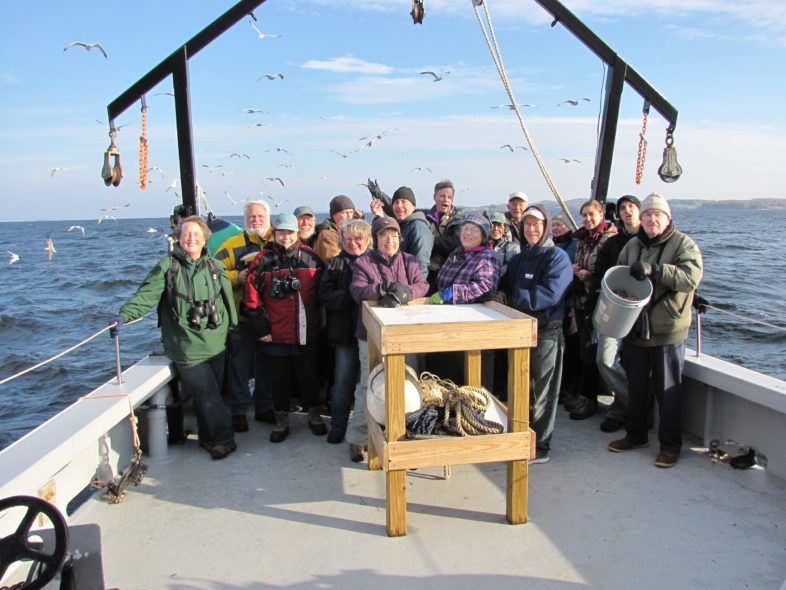
Craig Provost (center with watch cap) and fellow Vermont birders on a Lake Champlain “pelagic” trip, October 2013. © Allan Strong
Following on the heels of Fred (Pat) Pratt’s historic 2019 feat, in which he helped Pat notch his final 150-species county (Bennington), Craig turned his own attention to Vermont’s southwest corner in 2020. It took him less than half a year to reach his final capstone, with a Fish Crow in Bennington proper clinching species #150 for the county. In Craig’s own words: “I parked along Dewey Street (June 20th) near the Elm Street Market. On four prior occasions, I had positioned myself similarly in the general area and stayed on site for about an hour each time without success. After about 10 minutes of standing on the sidewalk near my parked Jeep, I heard a nasal ‘caw uh’, looked up and spotted the small crow headed west and eventually out of sight.” Typical Craig: no fist-pumping, no flourish, no one else there to share in celebrating. Even more telling, he kept birding Bennington County throughout 2020, notching a final tally of 162 species, with his last a Common Redpoll on November 28, and submitting 278 eBird checklists! Read the entire story about his incredible feat on the VCE Blog.
The Vermont 250 Club
The Vermont 250 Club requires even more dedication. This is a list of eBirders who’ve found 250 or more bird species in Vermont during one calendar year and reported them to Vermont eBird. To complete this, birders have to find about 90% of the species found in Vermont in any given year. Jim Mead has passed 250 species 9 times over the last decade! This year, Henry Trombley, Clem Nilan, Graham Rice, and Cedar Stanistreet joined him.
Cat Abbott (2018)
Zac Cota (2017)
Eddy Edwards (2017)
Bill Mayville (2017)
Mae Mayville (2017)
Jim Mead (2011, 2012, 2014, 2015, 2016, 2017, 2018, 2019, 2020)
Clem Nilan (2018, 2020)
Craig Provost (2018)
Graham Rice (2018, 2020)
Cedar Stanistreet (2020)
Henry Trombley (2019, 2020)
Alison Wagner (2017)
You can see the entire ranked list for each year by visiting the Vermont eBird Top 100.
Congratulations to everyone for a fun year of birding! We hope some of you will vie for top honors in 2021. You can follow the scoreboard all year long and see where you rank. Even if you come up short, all of the data collected in Vermont eBird is valuable for science, education, and conservation. Learn how to make eBirding your New Year’s resolution in 2021. Best of luck eBirding!
Thank You to All our Volunteers, Collaborators and Sponsors!
We’d like to thank the volunteer data experts that help us keep Vermont eBird data strong – Zac Cota, Sue Elliott, Spencer Hardy, Kyle Jones, Craig Provost, Nathaniel Sharp and Ian Worley. Every record entered into Vermont eBird is checked for accuracy, first by automated filters that flag unusual records, and then by expert reviewers who devote their personal time to ensure that your lists and the eBird database are as accurate as possible. Additionally, Ron Payne, and Ian Worley are hotspot editors for Vermont. If you run into them while out birding, let them know you are thankful for their hard work and contribution behind the scenes at Vermont eBird.
And finally, thank you to all of Vermont eBird collaborators and sponsors that help make Vermont eBird a special place.
